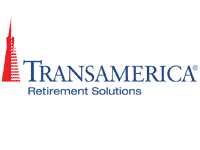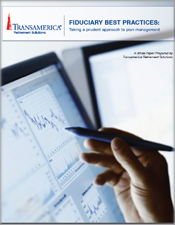Resource:
Fiduciary Best Practices: Taking a prudent approach to plan management
In this paper, we will present a summary of best practices that plan sponsors and fiduciaries can employ to ensure they are meeting their obligations.
Taking a prudent approach to plan management
Employing a set of best fiduciary practices remains a core objective of plan sponsors, retirement plan committees, and trustees. The current economic environment, market volatility, participant-related lawsuits, declining retirement account values, and fee disclosure legislation have compounded the need for retirement plan sponsors and plan fiduciaries to seek out and implement fiduciary practices to maintain regulatory conformity and to shield themselves from personal liability. To assist plan sponsors and fiduciaries, Transamerica Retirement Solutions has assembled a set of principles-based, prudent best practices that have become commonplace among retirement plans subject to the Employee Retirement Income Security Act ( ERISA) of 1974, which is the American federal statute that establishes minimum standards for pension plans in private industry. A large part of satisfying ERISA fiduciary duties relies simply on identifying fiduciaries and having those fiduciaries follow certain procedures that will guide them in acting prudently, known as “procedural prudence.”
Appointment of a fiduciary committee
The first essential step is to identify fiduciaries to administer the plan and oversee investment decisions. These appointments should be consistent with criteria outlined in the plan document. Though the fiduciary may be a single individual or the employer itself, a common best practice is to have several individuals on a plan committee who will divide up the duties. For large employers, there may even be separate committees – with one attending to administrative matters, such as overseeing employee communications and handling benefit claims, and another managing investment matters. The committee should be composed of personnel who are familiar with pensions and investments. Providing committee members with some periodic education on the plan’s operation and on ERISA fiduciary duties is also considered a best practice.
Additional considerations
Some plans identify the employer as the named fiduciary while also providing that the specific fiduciary duties can be delegated, which is a common and practical approach for many employers. While it is permissible to do this, naming the employer does not necessarily make it clear exactly which individual(s) have fiduciary responsibility for the plan. For example, “the employer” may include board members and senior officers who are not aware of the implications of the role. Therefore, making appointments to a plan’s fiduciary committee requires some thought. The goal should generally be to appoint individuals who will be making the actual decisions and thus will be in fact the fiduciaries. The idea here is that the best fiduciary decisions are made by people who understand their roles and what their duties entail. In addition, a committee should not consist of people too senior or too busy to fulfill these duties, nor those so junior that they do not have the authority to make independent decisions.
Written committee charter
In keeping with “procedural prudence,” a committee should have a written charter outlining its organizational responsibilities (chairman, secretary, quorum, etc.), how it operates and decides matters, how it conveys its decisions to others (such as by the secretary), and how often it meets. Periodic committee meetings Once appointed, the committee should meet regularly. Once a quarter is common for most organizations, though special meetings may be held when warranted. The secretary or other appointee should keep minutes for each meeting, which will concisely cover all the important issues discussed. Download the full whitepaper to learn more,

